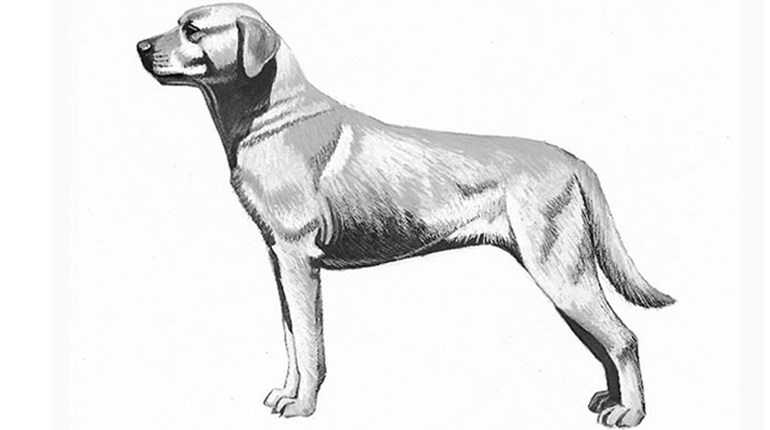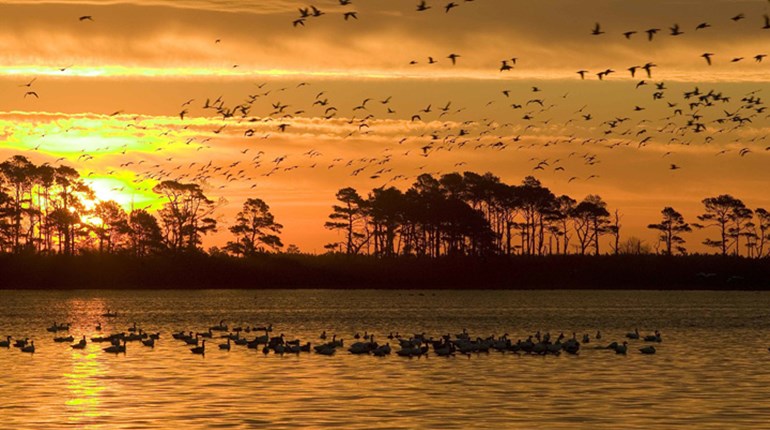The mallards cruised our spread with a ferocious speed fueled by the heavy December breeze at their backs. They banked back into the wind and for a moment it appeared they would stop short, but they skirted our decoys just closely enough to call the shot. Your author, age 12, stood to shoot, as did my father and his friend, Eric Megargel.
Two greenheads smacked the Susquehanna’s gray surface, while a third wing-clipped drake managed its way to the faster, ice-laden water at the center of the river. Eric sent George—a big, barrel-chested Chessie with a harsh coat and imposing shoulders—for the retrieve.
To this point my adolescence had been spent under the assumption that the Labrador was by far the superior retriever breed. Primarily this was so because that’s exactly what my father had told me. Why did Eric prefer Chessies? I surmised he just wasn’t as smart as my old man. But as George fought the ice, grabbed the crippled greenhead well downstream and swam effortlessly back against the current, I had a revelation all boys eventually experience: Perhaps Dad didn’t know everything.
River Otter DNA and Other Myths
I don’t really blame my father for the misinformation he fed me about the Chessie. Notions about the breed are almost certainly prone to more myths, mistruths and outright lies than any other of the Big Three retrievers.
Some of the phony intel defies common sense—the notion that the Chessie owes its aquatic agilities to an early crossbreeding with a river otter, for instance. The biologic probability of accomplishing this feat notwithstanding, it seems a daunting physical task for both Chessie, otter and human matchmaker.
Yet perhaps the greatest myth regarding the Chessie’s origins—and one that does seem somewhat plausible—is that it was bred by market gunners on Maryland’s Eastern Shore. As the myth goes, the market gunners kept few records, simply breeding their best, toughest duck dogs and ultimately developing a pure retriever with strong instincts.
“As they say, repeat a lie often enough, and it becomes the truth,” says Dyane Baldwin, former historian for the American Chesapeake Club (amchessieclub.org) and owner of Pond Hollow Chesapeakes. “It only takes a bit of thinking to realize the poor market gunner did not have the resources to develop a dog breed.”
Market gunners were busy feeding their families—they had neither the time nor financial capital to carefully design a breed, much less to deal with the hassles of weaning puppies. The actual caretakers of the Chessie’s development were the many wealthy ducking clubs lining the bay, including the Carroll Island Ducking Club, Spesutia Island Rod and Gun Club, and the San Domingo Farm Club, to name a few. They carefully selected dogs and kept detailed records, both of which fly in the face of commonly believed Chessie lore.
“Gun clubs did give pups to local market hunters, and the hunters may have bred them from time to time,” Baldwin says. “But the key selection work was done by the various duck clubs.”
For 100 years, a major portion of the early breeding records were assumed lost in a fire at the Carroll Island club. However, a major discovery was made in 2008 by John Sullivan Jr., author of Chesapeake Bay Retrievers, Decoys and Long Guns: General Ferdinand C. Latrobe—who served seven non-consecutive terms as mayor of Baltimore from 1875 to 1895—somehow saved the records and his descendants still possess them.
A Docile Dog?
Much of the Carroll Island records vindicate the argument by Chessie aficionados that the breed has been unfairly stereotyped as stubborn, lacking sense and possessing aggression. Those who perpetuate the stereotypes often do so under the errant logic that market gunners intentionally bred a rough-and-tumble dog. On the contrary, it’s clear that members of the Carroll Island Ducking Club valued the same qualities in a retriever as you and me. An entry by Gen. Latrobe in 1889 reads: “Fitz is kind and gentle and affectionate to the greatest degree. Dignified and quiet in the house, his behavior is without reproach.”
“I’m struck by the amount of dogs described this way in the records,” says Baldwin. “There’s this idea in people’s minds of a dark brown dog of an aggressive or unfriendly nature. I will hazard a guess that the few breedings by market gunners were not as careful as they should have been or they were looking for a more aggressive, protective dog. Such dogs stand out from other retrievers and thus the description of these dogs became the norm.”
According to Baldwin, rededicated breeding efforts since the 1970s have ensured the breed even more closely resembles its docile ancestor, Fitz. I can attest that George, the Chessie described in the introduction, was one such animal. I quickly learned not to pet him in the early-morning light, lest I spend the rest of the day with a brown nose nudging my elbow in search of further affection.
Not to suggest a Chessie is for everyone, but its stereotype as being stubborn unfairly impacts its popularity and—perhaps worse yet—leads to errors in training.
“A lot of people buy a Chessie and anticipate it will be stubborn when they go to train it,” pro trainer Tom Dokken of Oak Ridge Kennels told me at a training seminar. “But a lot of Chessies aren’t stubborn—they’re soft—which is easily confused when you get a command refusal. And what’s the first thing people want to do when they think a dog is being stubborn? Administer correction. That’s the worst thing you can do to a soft dog.”
Multiple Colors
Another major myth is the idea that the first dogs were available only in the color brown. In reality, today’s recognized colors of brown, sedge (red) and deadgrass (blonde) are as old as the breed itself. (Until recently it was theorized that deadgrass originated in the early 20th century; Carroll Island records indicate it’s as old as the other colors.)
Sailor and Canton—the two Newfoundlands famously rescued from a sinking vessel in 1807 that became the forebears of the Chessie—were red and black, respectively.
“Those colors over time are well proven to produce blonde and red,” Baldwin explains. “Carroll Island records list light-colored dogs and Jay Towner, another early impactful breeder, also lists multiple colors at his kennel. The brown and sedge dog was favored in the East and the deadgrass color was preferred in the Midwest and Canada.”
The Chessie Today
While no river otters were involved, genes from Newfoundlands Sailor and Canton were mixed with a variety of dogs. According to Baldwin, breed development focused on Irish water spaniels and additional Newfoundlands for water abilities and coat; bloodhounds for blood tracking in water; and local mixed-breed hounds for nose and persistence.
“It’s remarkable how well the duck clubs were able to achieve a consistent dog with the same general appearance and attributes when you consider the variety of breeds involved,” Baldwin says. “It speaks to how committed they were to making the Chesapeake the great ducking dog it was and remains.”
The modern Chessie retains such qualities as its ancestors’ thick double-coat; love of water; high intelligence; independent thinking; perseverance; and, perhaps its trademark, incredible toughness in icy seas and pounding surf.
“These are traits that were valued in the 1800s and that are still sought today,” Baldwin adds. “Overall the breed’s disposition has returned to its roots: A more social dog that worked for the ducking clubs and had watchdog instincts including a strong loyalty to its ‘family.’ I also consider it less of a one-person dog today. They are unbelievably loving and very quiet, sensibly natured dogs in the house. If the Chessie is the right dog for you, most people stick with them forever.”
The Chesapeake Bay retriever is nothing if not a connection to America’s rich waterfowling history. He arose in an era when men carved their own decoys; when the use of duck calls was just becoming fashionable; and when, by the mid-1800s, nearly every family living in Maryland’s bay counties owned one or more Chesapeakes.
“You can look at photos of dogs from that era and dogs today and they still look very much the same,” Baldwin notes. “Few breeds can say that.”





































